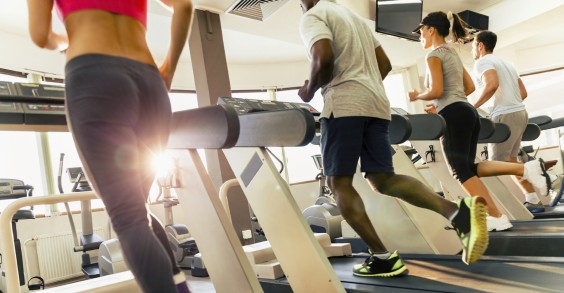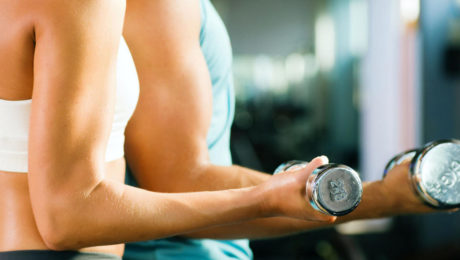Hello world!
Welcome to Kallyas Vertigo Demo Sites. This is your first post. Edit or delete it, then start blogging!
- Published in Uncategorized
17 Science-Backed Ways to Totally Crush Cardio Workouts
Love it or hate it, cardio workouts are essential to overall health and critical for athletic performance. Fortunately, getting a killer cardio workout doesn’t have to mean suffering through mile after mile on the track or trail. Check out these scientifically-backed tips to hack your workout and start seeing results—fast.
A typical cardio workout elevates the heart rate, helps improve lung efficiency, and burns a whole lot of calories and fat. And the good news is there are ways to get even more out of that workout. In addition to the non-negotiables (read: proper workout nutrition and hydration, along with a solid warm-up and cool down), here are 17 ways to get to work—and see better results than ever.
1. Think outside the ‘mill.
Cardio haters, rejoice! There are plenty of ways to up the intensity and hit the aerobic zone without running. One solution: using free weights like dumbbells for a fast-paced strength training session. That means minimizing the small talk (easier said than done!), and keeping rest between sets under 20 seconds to boost the heart rate and metabolism .
2. Stop and start.
Interval training (or alternating periods of all-out effort with periods of low-to-medium effort) can up the intensity of a run workout, while building lean mucles and maximizing calorie burn. (Score.) But high intensity interval training (HIIT) can go beyond just running. Try mixing things up with an interval workout in the pool or on a stationary bike for equally awesome results .
3. Tabata time.
These high-intensity workouts only last four minutes but provide better results than some hour long cardio sessions . Hop in the indoor rower and complete 20 seconds of work, followed by 10 seconds of rest for four minutes. Note: For less advanced gym-goers, avoid overexertion (or injury) with a modified tabata protocol (10 seconds on, followed by 20 seconds off), suggests Greatist Expert and trainer Rob Sulaver.
4. Mix and match.
Intervals have applications that go beyond running or cycling. Combiningstrength training and cardio into one workout will produce results in as little as eight minutes. Instead of sprinting then stopping, try performing a bodyweight exercise during the rest period .
5. Belt it.
Have a need for speed? Running on a treadmill might seem like a drag, but since the belt helps with leg turnover, there are few places you can go as fast. Plus, while it might be tempting to slow down outdoors, the threat of a face plant makes the treadmill a great tool for promoting consistency and pace per mile .
6. Up the incline.
Hop on the treadmill and crank up the speed, but don’t forget to adjust the incline. As the incline increases so will the heart rate, sending the calorie burn through the roof . Bumping up the incline to a 5.5 percent grade or higher can also strengthen the legs and core, not to mention improve running form and sprint speed (bylengthening the stride and increasing the number of steps taken per second) .
7. Just let go.
Of the handrail, that is. Holding onto the side of the treadmill does more harm than good . A surefire way to sabotage a workout, gripping the rails decreases energy output and oxygen consumption, significantly reducing the effectiveness of a workout . Go hands free then pump the arms from waist to chest, not across the body (which can slow you down).
8. Go off-road.
If the treadmill isn’t getting the job done, head for the great outdoors. Trail running, mountain biking, or even open water swimming can add variety to boring routine. Bonus: Uneven ground like sand or rocks require balance, athleticism, and agility to navigate the rugged terrain . Not up for all the impact? Mix things up (while giving those joints a break) with alternative machines like the StairMaster, elliptical, or rowing machine.
9. More kettlebell.
Grab the bell by the horns, or handle. Kettlebell traininghas been shown to provide greater cardiovascular benefits than traditional weight training methods. With only one piece of equipment it’s possible to improve oxygen uptake (or VO2 max), max heart rate, and functional performance. Start with the two-hand kettlebell swings and progress to the single arm snatch for better results in less time .
10. Get around.
Create a circuit training workout that stacks up a fast-paced combination of bodyweight and cardio-based exercises. By pairing resistance training with high-intensity aerobic moves back-to-back (think jump squats, burpees, and mountain climbers), the body will achieve results fast—including building muscle and burning fat .
11. Get loaded.
Maybe it’s adding a weighted vest. Or carrying a case ofbeer (post-workout of course!) to the other side of campus. Either way, carrying additional weight while walking, running, or during daily activities has been shown to improve intensity, recovery, and recruitment offast twitch muscle fibers (the ones that make us faster) . Just be sure to keep an eye on mechanics—even a few extra lbs can make it difficult to maintain good form, Sulaver says.
12. Go high-tech.
The trick to running a faster 5K or finding the motivation to HIIT the gym could be one mouse click away. There really is an app for everything, fitness included. No smart phone? No problem. Pick up a heart rate monitor, and consider a GPS feature that will track distance, pace, and the number of calories burned during a run . 13. Ride the beat. Music more your speed? Forgo the fancy fitness gadgets and crank up the tunes. Listening tomusic during exercise has been shown to improve performance, increase motivation, and put distractions (like negative thoughts and fatique) on pause .
14. Get social.
Building a workout routine around team sports, group activities, or fitness classes can boost performance during aerobic exercise. Can’t find a group workout that meets your needs? Train with a partner to make the entire gym experience more enjoyable, with an extra boost of accountability .
15. Fill ‘er up.
Need an excuse to grab another cup o’ Joe? A pre-workout dose of caffeinecan provide the pick me up needed to get moving, and improve endurance along the way . Just be careful not to overdo it: No one wants the shakes when it’s time to lift some weights.
16. Play (the right) mind games.
Mental fatigue can be the downfall of a workout. Studies have shown that if the brain is tired, performance tends to suffer . Re-energize the mind and body with a new running route, fitness class, or workout routine. Or, create a mantra that can be recited for a boost of motivation when exercise seems like a chore or a workout is dragging along.
17. Timing is everything.
Research suggests that working out first thing in the morning is best for creating and sticking to a habit of exercise. However, not everyone is a morning person. That’s alright. The good news is that the body will adapt to training at any point in the day, so long as it is done on a consistent basis . Turns out that, when it comes to killing a cardio workout, anytime is better than never. With all these cardio workouts to choose from, it might be possible to overdo it. Don’t get carried away. Instead, take 24-48 hours off before training the same muscle groups. Make time to foam roll key areas like the hamstrings, quads, calves, groin, and back. The payoff: better recovery, increased muscle growth, and being better prepared for that next workout.
- Published in Cardio
The 10 Best Nutrition Tips Ever
Diet advice is a lot like fashion. Trends come—wedge sneakers, drop-crotch pants, those skirts that are short in the front and long in the back—and a year or two later they seem hopelessly out of date.
But the truly stylish always look smart; you’ll never see a photo of Pharrell Williams wearing crocs or Victoria Beckham in a meat dress. Here at Eat This, Not That!, we see the same thing when it comes to weight loss: Those who stay slim don’t follow diets or nutrition trends. They follow common sense eating strategies that keep them looking fit for life.
Giving up gluten, throwing back shots of apple cider vinegar, juicing everything in sight—try them if you think they make sense. But when those of-the-moment diet fads are gathering dust in the back of your metaphorical closet, the simple, smart, sensible approaches will be there like a favorite pair of jeans or a perfect little black dress—look-great staples guaranteed to never go out of style. (As an added bonus, add a daily cup to your routine—of green tea, that is. Here’s all you need to know about green tea and weight loss.)
1 HIDE YOUR WEAKNESS.
If you see it, you’ll eat it. If you don’t see it, you’ll still eat it—but not so much. That’s what a study at Google’s New York office, dubbed “Project M&M” found. Office managers discovered that placing the chocolate candies in opaque containers as opposed to glass ones, and giving healthier snacks like nuts and figs more prominent shelf space, curbed M&M intake by 3.1 million calories in just seven weeks. A similar study published in the Journal of Marketing found that people are more likely to overeat small treats from transparent packages than from opaque ones. Out of sight, out of mind, out of mouth.
2 USE THE 1 IN 10 RULE.
For every 10 grams of carbohydrate listed on the label, look for at least one gram of fiber. Why 10:1? That’s the ratio of carbohydrate to fiber in a genuine, unprocessed whole grain. The recommendation comes from a study published in the journal Public Health Nutrition that evaluated hundreds of grain products; foods that met the 10:1 ratio had have less sugar, sodium, and trans fats than those that didn’t.
3 BOOST FLAVOR TO CUT CALORIES.
Ever notice how everything inside a McDonald’s—the burgers, the fries, the shakes—smells exactly the same? That sameness of scent is actually a tactic that can inspire you to consume more calories. (But if you’re really jonesing for a burger fix, we also have suggestions on what to eat at McDonald’s.) A study in the journal Flavour found that the less distinctive the scent of a particular food, the more you’ll eat of it. Adding herbs and sodium-free spice blends is an easy way to take advantage of the sensory illusion that you’re indulging in something rich—without adding any fat or calories to your plate. Furthermore, a recent behavioral study that taught adults to spruce up meals with herbs instead of salt led to a decrease in sodium consumption by nearly 1000 mg a day (that’s more salt than you’ll find in 5 bags of Doritos!).
4 CHILL PASTA TO MELT FAT.
You can gain less weight from a serving of pasta simply by putting it in the fridge. The drop in temperature changes the nature of the noodles into something called “resistant starch,” meaning your body has to work harder to digest it. Cold pasta is closer in structure to natural resistant starches like lentils, peas, beans, and oatmeal, which pass through the small intestine intact and are digested in the large intestine, where—well, it gets kinda gross from there on out. A study in the journal Nutrition & Metabolism found that adding resistant starch to a meal may also promote fat oxidation. Suffice it say, colder noodles = hotter you. But you’ve got to eat it cold: Once you heat the pasta up again, you destroy the resistant starch.
5 DIM THE LIGHTS TO GET LIGHTER.
A study of fast food restaurants published in the journal Psychological Reports found that customers who dined in a relaxed environment with dimmed lights and mellow music ate 175 fewer calories per meal than if they were in a more typical restaurant environment. That may not sound like a dramatic savings, but cutting 175 calories from dinner every night could save you more than 18 pounds in a year!
6 EAT, DON’T DRINK, YOUR FRUIT.
Juicing may be the rage, but like a certain Mr. Simpson, some juice can do more harm than good—including OJ. Researchers at the Harvard School of Public Health found that people who consumed one or more servings of fruit juice each day increased their risk of developing type 2 diabetes by as much as 21 percent. Conversely, those who ate at least two servings each week of certain whole fruits— particularly blueberries, grapes, and apples—reduced their risk for type 2 diabetes by as much as 23 percent.
7 EAT BEFORE YOU EAT.
Eating an appetizer of a broth-based soup or even an apple can reduce total calorie intake over the course of the meal by up to 20 percent, according to a series of “Volumetrics” studies at Penn State. Consider that, according to the Journal of the American Medical Association, the average restaurant meal contains 1,128 calories. A 20 percent savings, just once a day, is enough to help you shed more than 23 pounds in a year.
8 CHOOSE PAPER, NOT PLASTIC.
Here’s a simple way to improve the health of your shopping cart: A series of experiments by Cornell University looked at the effects of payment method on food choice. When shoppers used credit cards, they bought more unhealthful “vice” foods than they did “virtue” foods. Researchers suggest that you’re less likely to impulsively buy junk food if it means parting with a hundred dollar bill than swiping plastic.
9 WATER DOWN THE CALORIES.
You’ve been told to drink 8 glasses of water a day, but why bother? Well, what if staying hydrated could strip pounds off your body? According to a study in the Journal of Clinical Endocrinology and Metabolism, after drinking approximately 17 ounces of water (about 2 tall glasses), participants’ metabolic rates increased by 30 percent. The researchers estimate that increasing water intake by 1.5 liters a day (about 6 cups) would burn an extra 17,400 calories over the course of the year—a weight loss of approximately five pounds!
10 REMIND YOURSELF TO LOSE WEIGHT.
A recent study published online in Health Promotion Practice found that people who received weekly text reminders of their daily “calorie budget” and motivational emails made healthier meal and snack choices. A simple hack to help you slim down: set up reminders on your smartphone, so when 6 a.m. rolls around, it’s: You make 1200 calories-a-day look so good! And at lunchtime: Salad for the six-pack, baby!
- Published in Nutrition
The Weird Trick That Can Prevent Back Pain During Strength Training
The deadlift is an amazing exercise, specifically for shaping your glutes—our top goal after flat abs as bikini season looms. In fact, we’ve called it The One Exercise Every Woman Should Do—and that’s because it also targets your quads, hamstrings, core and lower back. But lower back issues could be the reason so many women shy away from the powerhouse move.
When done with poor form, the deadlift puts too much weight on your back, which not only means your legs and butt won’t get as much love—and could lead to major back pain. The most common (pain-inducing) mistake in this exercise is not generating enough force from your legs. “You must bend your knees to get down low and generate movement from your legs rather than your back,” explains Mike Bracko, Ph.D. and exercise physiologist in Calgary, Canada. Another issue: using too much weight. If you’re not used to performing deadlifts, use an empty bar or even a PVC pipe or broomstick the first few times you attempt the move—it will help you work on nailing the movement pattern. Add weight slowly over time as you progress, advises Bracko.
There’s also simple pro lifter’s trick that could help solve the pain problem. It’s called the “valsalva maneuver” and, though it sounds fancy, it basically means that you hold your breath during the “concentric” (when the weight goes up) phase of the movement. Then, you exhale at the top before lowering the weight back down. (Find out how to Breathe Your Way to a Fitter Body.)
“It’s been shown that holding your breath during the concentric phase helps to maintain both intra-thoracic and intra-abdominal pressures to stabilize the spine and actually makes a lifter stronger,” explains Bracko.
Translation: When you hold your breath inside the body (in the thoracic cavity), it puts pressure on the spine, helping to stabilize it, which then helps to prevent low back injury or pain. And science backs this up. But bare in mind that this technique is not for first-time lifters, and some evidence points to the possibility that holding your breath could lead to increased blood pressure (so if yours is high, definitely skip this technique).
“Beginning exercisers should exhale when the exercise is the hardest (during the lift), and inhale with the exercise is the easiest (when lowering the weight back down),” says Bracko. If you do attempt the valsalva maneuver and feel lightheaded or dizzy, do not continue to try to hold your breath. Take a break and then go back to the beginner’s strategy. No one’s judging you!
- Published in Weight Training







